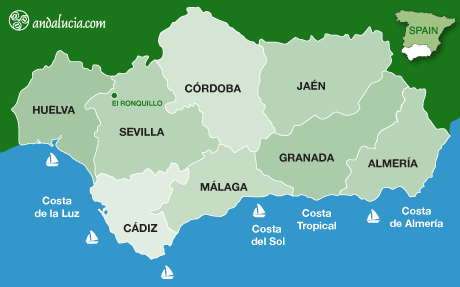EL RONQUILLO
by Saskia Mier
El Ronquillo takes its name from the proprietor who, in the fifteenth century, made two roadside cafes/bars that made the foundations for the municipality. It has been awarded the Nacional de Embellecimiento Municipal (National Municipal Beauty) prize several times, but the town centre now has the N-630 roadway crossing it from North to South. It has about 1400 inhabitants.
HISTORY
The first two neighbourhoods of El Ronquillo were Barrio de Zufre and Barrio de Santa Olalla. Its current name is the diminutive of the nickname with which the owner of these two establishments was known, 'El Ronco'.
As from 1653, El Ronquillo belonged to Villa de Señorío de Santa Olalla.
During the War of Independence in the nineteenth century, the village suffered great damage; however the inhabitants remained faithful to a destitute Monarchy.
In March 1811 a French mail bearer of important news on the conquest of Badajoz, stopped at the cafe/bar in El Ronquillo of mayor, José Diego Fernández Rufo. Faithful to King Ferdinand VII, he ordered militant, Juan Gomez, to lead the mail bearer to Seville. Almost at their destination, the French mail bearer was killed. The mayor, militant and a priest were taken on foot to Seville, where all were killed, except the priest, who was killed in Plaza de San Francisco.
The brother of the murdered mayor and 21 other neighbours asked Ferdinand VII the mercy of village title for El Ronquillo and its independence from Santa Olalla. In 1817 the King granted such a request for the loyalty to the Crown.
Hotels
Book hotels in El Ronquillo
THINGS TO SEE
Iglesia del Divino Salvador
The church was built during the first years of century seventeenth century. In 1774 began it was made bigger and finished three years later in 1777. It was later reformed again in 1903, after being closed for several years due to its damaged state. Located on Calle Iglesia.
Ermita de Nuestra Señora de Gracia
The chapel was built in the sixteenth century and sits next to a pilgrim's cross of the Middle Ages. Located in Calle Nueva.
Venta El Ronco
One of the former cafe/bars used as a stopping point for the bandits in the area. It dates to the eighteenth century. Today it is a private home. Located in Plaza de la Constitución.
Plaza de la Constitución
The square dates to the fifteenth century, although has undergone many restorations. In 1851 it was given initially given the name Plaza de la Constitución, later changing to Plaza de la República and Plaza de Calvo Sotelo. It is in 1986, when it returns to its original and current name, Plaza de la Constitución, as a tribute to the restoration of democracy.
Plaza de España
A square dating to the eighteenth century, when it was called Plazuela. Over the years its name has undergone several changes calling itself Plazoleta, Marques de Granja, Plaza Castelar, Plaza de la Falange Española and it is in 1986 when it was finally called Plaza de España. Mainly used as a meeting point.
Monumento Homenaje a la Profesión de Cisquero
This monument was built as homage to charcoal manufacturers who made piles of wood and were burnt in the mountains. This profession allowed huge growth in the economy of El Ronquillo during the twentieth century and in post-war years. Located in Calle Romero Martel.
Monumento al Bellotero
A monument built in homage of those men who made money collecting acorns and selling them on illegally to make a small profit. Located in Plaza Altozano.
COUINTRYSIDE WALKS
El Ronquillo offers a range of walking routes for beginners right threw to more advanced walkers. These include Vía Verde de El Ronquillo, Ruta Los Cachones-Calamón, El Hoyuelo, Berrocal-Almadén, Ruta de los Lagos, Ruta del Barranco de la Lana, Ruta de la Molineta, Ruta de los Cachones, Ruta de la Minilla, Ruta de la Parrita I, Ruta de la Parrita II, Ruta del Casarejo, Ruta de los Brezales, Ruta de los Portugués, Ruta Sierra Clara I, Ruta Sierra Clara II, Ruta del Torreón and El Pichi.
GASTRONOMY
El Ronquillo offers dishes rich in local produce from the area. Game meats are specifically popular including venison, wild boar, hare, partridges etc. Other typical dishes include gurumelos (wild mushroom), garbanzos con bacalao (chickpea stew with cod), gazpacho and migas (fried bread). Sweet treats worth trying are the sweet pastries called pestiños.
FESTIVALS
Cabalgata Reyes Magos
Three Kings procession on the evening of the 5 January.
Las Candelarias
Celebrated the 2 February.
Carnaval
Celebrated in February.
San Blas de Sebaste
Celebrated on the 3 February.
Romería de San José
Celebrated in March.
Cruces
Celebrated in May.
Enramá
Celebrated the 24 June.
Fiestas Populares
Celebrated the beginning of August.
Fiesta Nuestra Señora Virgen de Gracia
Celebrated the beginning of September.
La Cachetía
Celebrated the 1 November.
LOCATION
El Ronquillo is located 50km from Seville. To get there, take the SE-30 north leaving Seville, merging onto the A-66 Autovía de la Plata. Take exit 771 for N-630-El Ronquillo and take the second exit at the next two roundabouts. Turn right onto the N-630 and continue until you reach El Ronquillo.
Book your stay in Andalucia Now!
